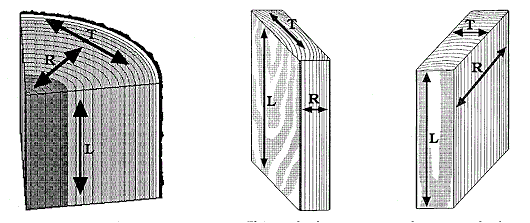 |
| Illustrated Mitered Door Frame |
People like mitered door frames, I suspect, because they look cool. They're also hard to make, and may therefore be a sign of the cabinet-maker's skill.
Ask a cabinet maker, however, and he or she may well tell you to NEVER buy or make a mitered door. See this link for responses to the "miter question" on Woodweb.com. The reason isn't just because of how hard it is to find a well-made mitered door frame. It's because the miter joint is a natural candidate for opening over time, due to the way wood moves.
Here's why some cabinet makers think the miter is a suspect joint, prone to opening: Take a look at this drawing of a tree trunk. Imagine cutting a miter in the center board on the right of the image - from the corner where the end (T) and the face (L) meet, 45 degrees down along the face (L). Now imagine joining two such mitered boards together, end to end, forming a 90 degree corner. Many woodworkers fear that as each piece expends and contracts along the "T" axis, the mitered joint will open up.
If you're a geometry whiz, you might object: after all as long as the rate of movement along the T and L axes is the same, each side of the joint should be able to peacefully expand and contract, without a gap opening between the pieces. That's true, as far as I can tell. But here's the rub: wood doesn't move the same amount in all directions. In fact, the board in the center of the drawing will move most along the "T" axis, and least along the length of the board, "L". So is that the reason a miter will open? It might be.
Another reason might be the maker's choice of how to keep the joint together. I use mortise and tenon joints on my mitered doors. And I don't spread the glue around the whole joint: I only put glue in the mortise and on the tenon. If one did use glue across the whole joint, this could prevent movement of the joint faces along each other, building up stress in the joint, resulting in an eventual popping out of the joint. On the other hand, if one were to use an epoxy glue - FORCING the joint to stay together - you'd trade a bomb-proof joint for the buildup of stress somewhere else in the frame, possibly resulting in warping of the whole frame, over time.
There's one final reason some cabinet makers might eschew and deride the mitered frame: it can be nearly impossible to make a good, tight miter consistently and quickly. Many of the mitered doors I've seen are patched up with gap-filling wood putty (bound to deteriorate over time), or forced together with screws and/or glue (a recipe for warping).
As for myself, I spent the weekend trying a few techniques for making perfect mitered doors, both quickly and well. My customer had asked for it, and the time to start cutting lumber is quickly approaching. This morning, I had an Aha! moment. And this evening I tested my idea in the shop. I'm happy to report I have conquered mitered door frames (and all miters, for that matter) with a quick and easy jig that I have NEVER heard of before, and couldn't find on the web.
I am debating whether to post my solution here :)
In the meantime, rest assured: it IS possible to have well-made mitered furniture without going to a factory CNC'd or false mitered solution. Not only that, but mitered doors don't have to come apart or warp over time. With the right joint - one that allows the miter joint to move with the seasons - a mitered door frame can last a lifetime.

No comments:
Post a Comment